The HTC One (M8) Review
by Anand Lal Shimpi & Joshua Ho on March 26, 2014 7:00 PM EST- Posted in
- Smartphones
- HTC
- Mobile
- HTC One
Snapdragon 801 Performance
The M8 is the first smartphone we’ve tested to use Qualcomm’s newly announced Snapdragon 801 SoC. At a high level the 801 is a frequency bump enabled by a 28nm HPm process push, giving it a tangible increase in performance (and potential decrease in power consumption) compared to the outgoing Snapdragon 800. The table below compares the 801 variants to the Snapdragon 800:
| Snapdragon 800/801 Breakdown | ||||||||||
| SoC Version | Model | Max CPU Frequency | Max GPU Frequency | ISP | eMMC | DSDA | Memory IF | |||
| MSM8974VV | v2 | S800 | 2.2GHz | 450MHz | 320MHz | 4.5 | N | 800MHz | ||
| MSM8974AA | v2 | S800 | 2.3GHz | 450MHz | 320MHz | 4.5 | N | 800MHz | ||
| MSM8974AB | v2 | S800 | 2.3GHz | 550MHz | 320MHz | 4.5 | N | 933MHz | ||
| MSM8974AA | v3 | S801 | 2.3GHz | 450MHz | 320MHz | 5.0 | Y | 800MHz | ||
| MSM8974AB | v3 | S801 | 2.3GHz | 578MHz | 465MHz | 5.0 | Y | 933MHz | ||
| MSM8974AC | v3 | S801 | 2.5GHz | 578MHz | 465MHz | 5.0 | Y | 933MHz | ||
In most parts of the world the M8 will ship with a 2.3GHz Snapdragon 801. In Asia/China however we’ll see the 2.5GHz MSM8974AC v3 SKU instead.
Compared to the outgoing Snapdragon 800, peak CPU performance shouldn’t increase all that much. What we may see however is an improvement in power efficiency thanks to the improved 28nm HPm process.
It’s really the GPU that will see the largest increase in performance. With a maximum speed of 578MHz and paired with faster LPDDR3-1866 memory, we should see up to a 30% increase in GPU bound performance over Snapdragon 800 designs.
- Physics
| Snapdragon 801 vs 800 vs 600 | |||||||
| HTC One (M8) - Snapdragon 801 | Google Nexus 5 - Snapdragon 800 | HTC One (M7) - Snapdragon 600 | 801 vs 800 | 801 vs 600 | |||
| SunSpider 1.0.2 | 772.8 ms | 686.9 ms | 1234.8 ms | -12% | +37% | ||
| Kraken Benchmark 1.1 | 6745.2 ms | 7245.9 ms | 12166.5 ms | +7.4% | +45% | ||
| Google Octane v2 | 4316 | 3726 | 3103 | +16% | +39% | ||
| WebXPRT Overall | 373 | 392 | 244 | -5% | +53% | ||
| AndEBench - Native | 17430 | 17480 | 12381 | -1% | +41% | ||
| 3DMark 1.1 Ultimate | 19631 | 17529 | 10519 | +12% | +87% | ||
| 3DMark 1.1 Ultimate - Physics | 50.5 | 51 | 33.1 | -1% | +53% | ||
| Basemark X 1.1 - HQ | 12194 | 11275 | 4807 | +8.1% | +154% | ||
| GFXBench 3.0 - Manhattan Onscreen | 11.1 fps | 9.3 fps | 5.1 fps | +19% | +118% | ||
| GFXBench 3.0 - Manhattan Offscreen | 10.4 fps | 8.7 fps | 4.4 fps | +20% | +136% | ||
| GFXBench 3.0 - T-Rex HD Onscreen | 29.9 fps | 24.3 fps | 12.6 fps | +23% | +137% | ||
| GFXBench 3.0 - T-Rex HD Offscreen | 27.9 fps | 22.9 fps | 12.6 fps | +22% | +121% | ||
CPU Performance
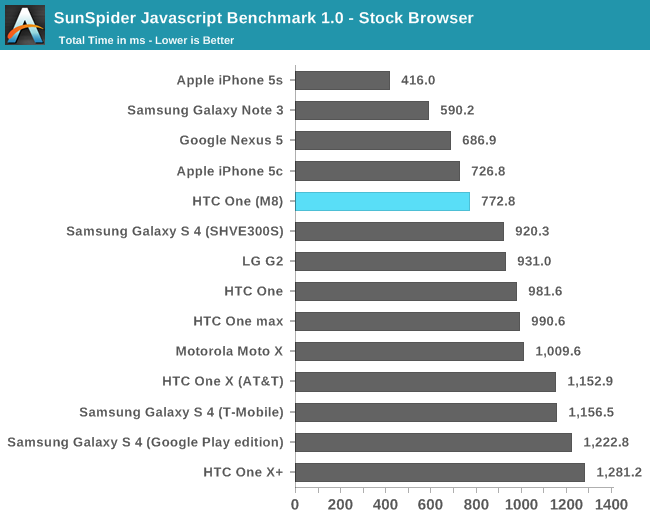
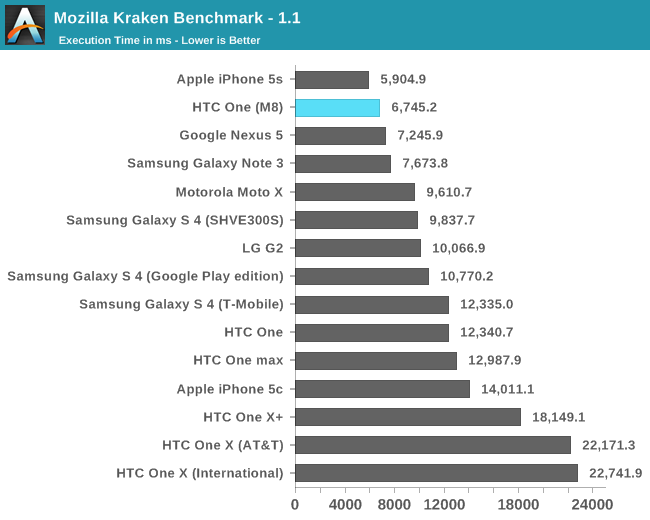
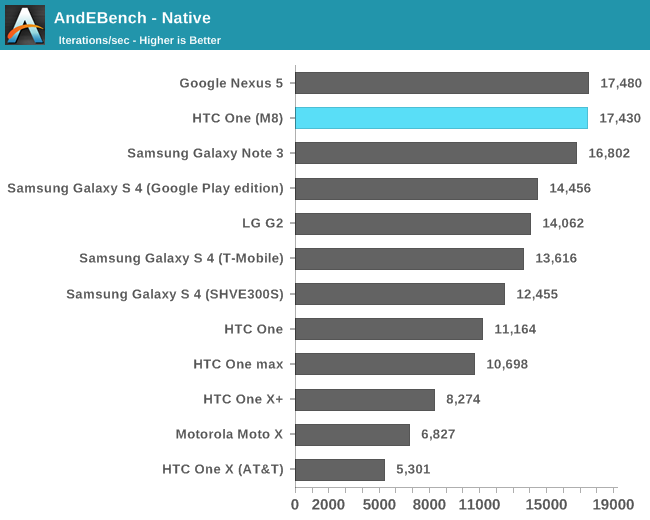
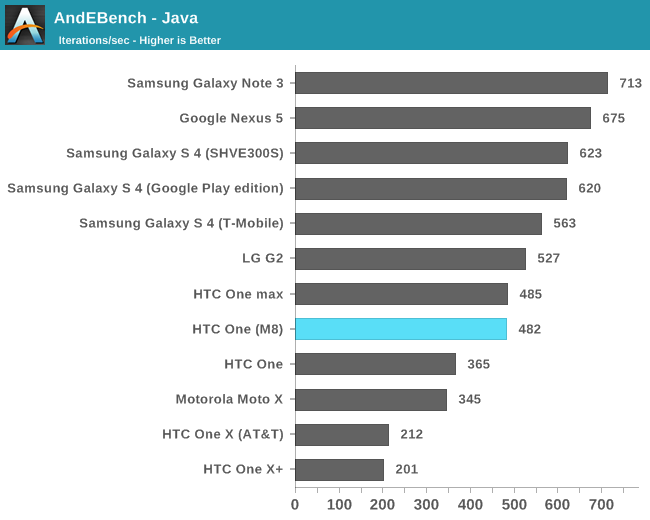
GPU Performance
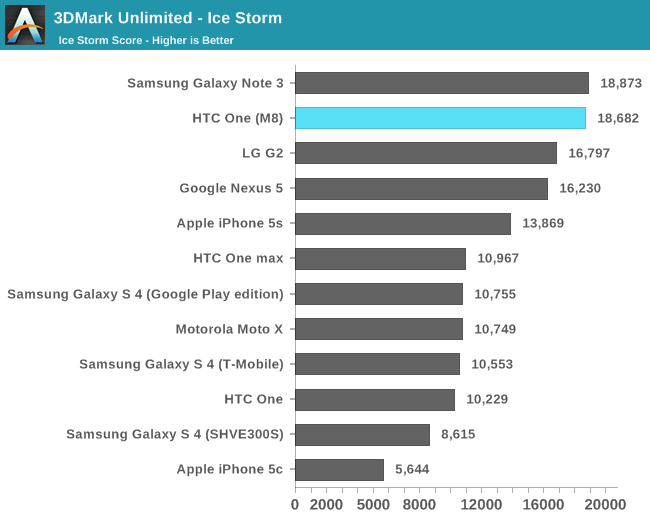
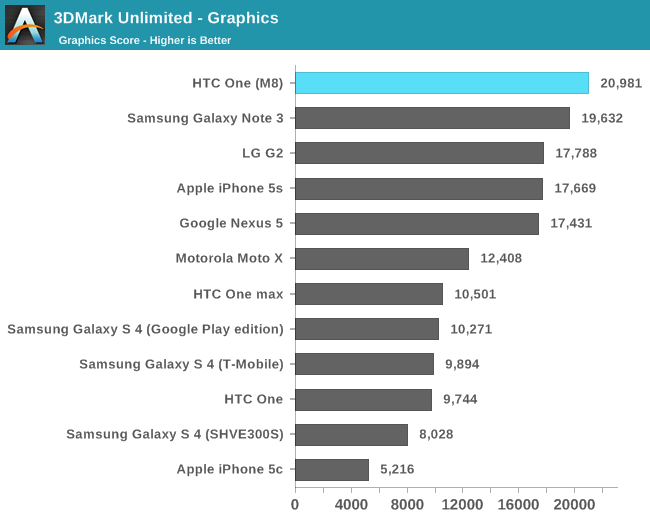
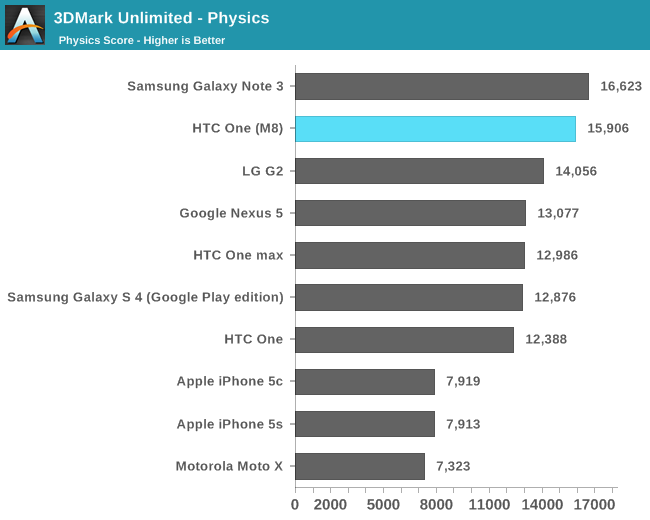
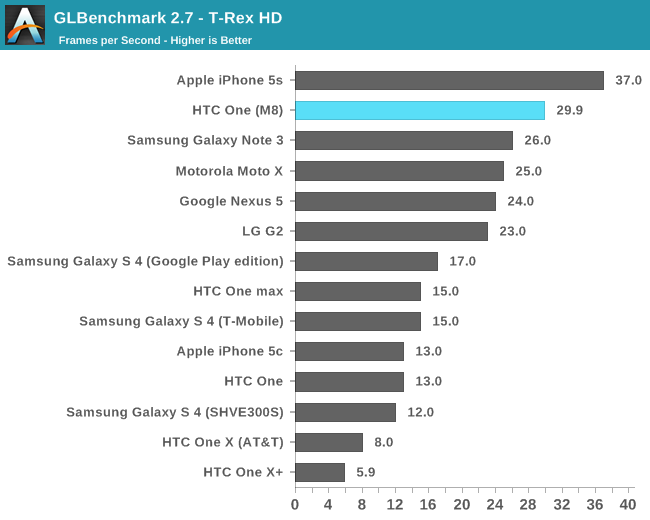
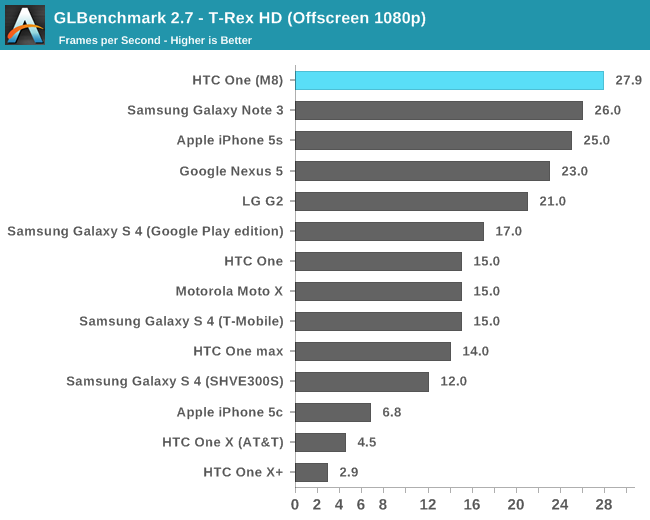
NAND Performance
The One is available in either 16GB or 32GB configurations, there are no higher capacity versions offered. There is now a micro SD card slot on the right side of the device, just above the volume rocker.
Despite using a Snapdragon 801 SoC, the internal storage is still an eMMC 4.5 solution.
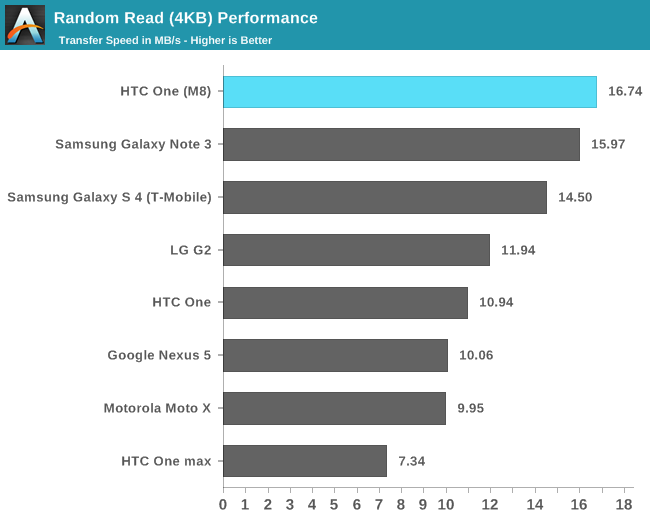
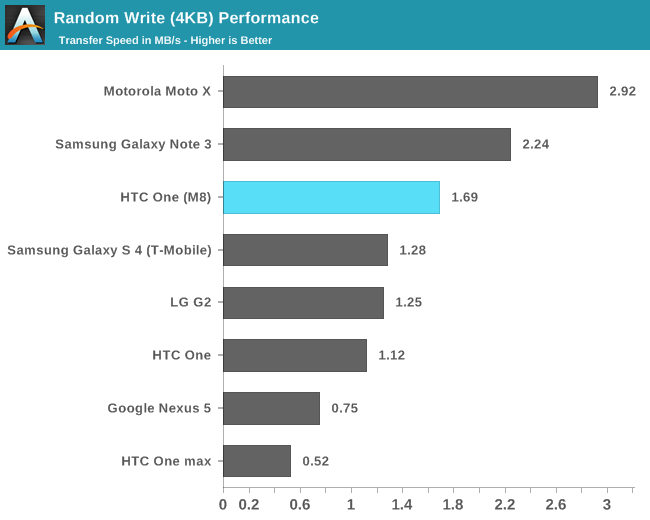

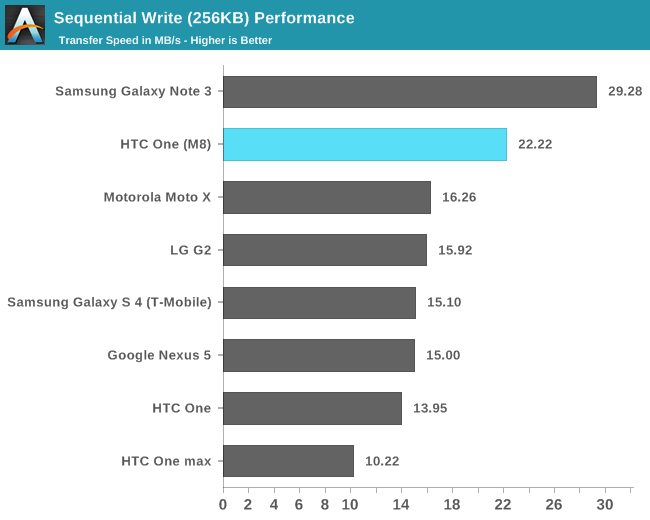


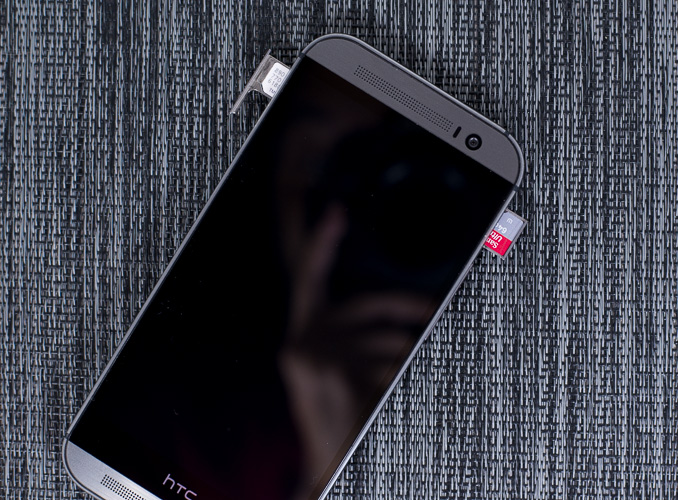








222 Comments
View All Comments
berantle - Friday, March 28, 2014 - link
@Death666Angel, it is not a stupid argument. It is a rational reasonable argument.Fundamentally, it is a phone first and whatever else second. Yes, it is capable of other things but it cannot fully replace what other purpose-specific devices do better. Taking into account the size, form factor and the practical realities of smartphones, it is actually pretty foolish to expect that these fully replace the proper devices for it.
The main point about the camera as stated ad nauseum is the camera's resolution is sufficient for what many people use the photos taken from it - i.e. post onto social websites and blogs, and view them on their 1080p (1920x1080) Full HD TV. The 4MP resolution of the HTC One (both M7 and M8) camera equates to 2688 x 1520 images at 16:9 ratio. This size provides more than enough detail for 1080p Full HD TVs that are very common nowadays. Posting on Facebook, Google+, Instagram, Snapchat, etc, the image sizes shown on screen rarely, if ever, go as large as 1920x1080.
Good photos are rarely just about how detailed it shots. It's about picture composition/framing, quality of lenses and proper focusing, and a basic understanding and proper use of photography technicalities. If you're a crap photographer, having a higher number of pixels only means you're likely to be taking crap photos that have more detail.
That all said, personally, 4MP (2688x1520) pictures are at the lower end of my requirements. It would be nice to have a sensor of more 2-micrometer pixels than 4MP. As it is, the 4MP picture resolution of the HTC One camera is adequate for my needs.
Thermalzeal - Friday, March 28, 2014 - link
I don't think it's a broken record. While photo's look similar on a phone's display, they certainly differ in quality when viewed on a higher DPI display. You are right that there is a small audience that appreciates this, but this is a high end product to top off the premium tier of HTC phones. I like the concept of the dual camera, but it would have been nice to get at least a 12MP sensor since they are not really cost prohibitive.Also in the end, you can always down sample a photo, but in the future where bazillionK resolution is the standard, these photo's will look like your mom and dad's black and whites.
evonitzer - Saturday, March 29, 2014 - link
"I like the concept of the dual camera, but it would have been nice to get at least a 12MP sensor since they are not really cost prohibitive."But at what cost in performance? Low light performance will suffer. I do not understand people's difficulty in this minor complexity. The resolution is good enough, and enables greater performance in low light. Daylight shots will lack resolution. We do not need to boil it down any further to "this camera is crap" or "this camera is great". This camera does exactly what it is designed to do and it is up to shoppers to decide if it is right for them.
dimsum888 - Saturday, March 29, 2014 - link
compared to other flagship phones it doesn't perform well. at its price point it is expected all features are comparable to other high end phones.jospoortvliet - Sunday, March 30, 2014 - link
No, compared to other phones it does worse at still pictures with outside day light and better at moving picks and at night. So there is a choice: if you want to take pics inside orat night or of moving objects, the HTC one is best. If you take pics of static objects in good lightning conditions, buy another phone. I know why I prefer my HTC, which makes the better pics in 90% of relevant (for me) circumstances but ymmv.notposting - Monday, March 31, 2014 - link
Or get one of the Lumia's which take better pics both outdoors, indoors, good light, no light, have OIS, have the resolution to allow cropping, some allow for saving a copy in RAW.Between the Note 3, S4/S5, iPhone 5S, Lumia 92x/1020, LG G2, and the Sony lineup, there is basically little reason to choose the HTC if the camera is at all important to you.
augustofretes - Monday, March 31, 2014 - link
The resolution isn't good enough. The detail capture is obscenely poor. People zoom-in their images to see their friends and stuffs in the picture you know? While I agree that 12MP is not really necessary, 8MP + OIS are way a better choice than the nonsense of 4MP + secondary sensor for gimmicky procedures.Blown503 - Monday, March 31, 2014 - link
5 megapixels is an 8x10 picture on paper, 8 megapixels is a 16x20 picture on printed paper. The are printed @ 300 dpi.Chaser - Thursday, April 10, 2014 - link
I've owned the HTC One M7 and if its one area I was disappointed in was its versatility as a point and shoot. Yes the low light level is very good but with larger scale more distance "scenic" outdoor photos there is a difference with the high pixel phone cams. So yes, while a photo of a flower pot on a table may not look "noticeably different" the quality of even smartphone cams vary. I know because I go through flagship smartphones at least once a year sometimes sooner and I use their cameras frequently as I have no desire to carry around an extra camera.Let me make another distinction. If you do take a photo and later desire to crop and resize that photo (and post it on social media for example) the higher pixel cameras won't lose detail like the lower pixels cameras such as my former HTC One would. So enough with the "broken record" about pixels not mattering. I can assure you they do. Even smart phone camera image quality and versatility has improved significantly since two years ago. I sold my HTC One because I was disappointed with it's overall camera quality. I am much happier with my new LG G2's higher pixel camera.
perpetualdark - Wednesday, April 2, 2014 - link
While I agree that the HTC One camera is good enough and even better than other phones in certain situations (ie low light), the megapixel argument does hold water. Unless every picture you take is at standard zoom, the number of pixels in a smartphone is very important. This is NOT a camera with a physical zoom lens on it, so zoom is purely a factor of megapixels. The more pixels you have, the more you can zoom in.Keep in mind, every other camera on smartphones has a smaller lens aperture though, so while you can zoom way in with higher megapixels, you have to have longer exposure to get the same amount of light to the sensor to get the same picture quality, and again the lower the ambient light, the worse the picture. In well lit scenes that are fairly static, an 8 or 16 megapixel camera will be able to zoom way in and get a great picture that is still high resolution even on a 1080p television or monitor. The 4mp might be better in low light and might take great pictures at no zoom, but it cannot touch the zoom capabilities of the higher megapixel cameras. Not without a physical zoom lense, and you aren't going to find that in a smartphone.
Bottom line is that if you like to take a lot of pictures where you need to zoom in, and don't want to always be carrying around a professional grade camera, this isn't the phone for you. And for crying out loud, if you are going to make an argument, at least make a valid one..